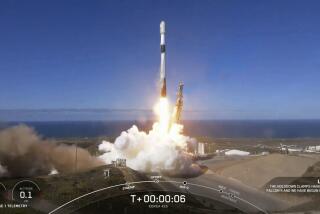Satellite to Study Atmospheric Pollutants
- Share via
After a series of delays, NASA launched its Aura satellite into orbit Thursday at 3:01 a.m., commencing a six-year mission that could provide the most detailed measurements to date of the Earth’s ozone layer, pollution levels and changing climate.
The $785-million satellite is the first to focus on pollution in the troposphere, the roughly six-mile-thick region in the atmosphere that contains the air we breathe. The satellite -- the last of NASA’s three Earth Observing System satellites -- will track five major air pollutants as they disperse around the globe. “Aura is a mission that’s designed to understand and protect the very air that we breathe,” said chief scientist Phillip DeCola.
Orbiting 438 miles above Earth, Aura will continue to follow damage to the global ozone layer, which shields the planet from harmful solar radiation. NASA scientists hope the satellite will show that the layer is recovering now that most of the chemicals that damage it are regulated.
During the mission, Aura will monitor changes in Earth’s climate, refining both short-term models that allow forecasters to predict the weather and long-term models of climate change.
Together with the two previous Earth Observing System satellites -- Aqua, which monitors the planet’s oceans and water cycle, and Terra, which monitors the land -- Aura will provide integrated data on how the planet works, linking oceanographic and geologic processes to global weather patterns and changes in the atmosphere caused by humans.
Launched on a Delta II rocket, the 6,500-pound satellite was built by Northrop Grumman Corp. in Redondo Beach and carries four main sensors, two of which were designed and constructed by the Jet Propulsion Laboratory in Pasadena.
Two sensors will focus on ozone -- a pollutant at ground level but a vital component of the upper atmosphere that blocks dangerous ultraviolet radiation.
Pollution has damaged the upper ozone layer, leaving a hole over Antarctica.
Aura will monitor both ozone pollution near the ground and the protective ozone layer higher up -- as well as air pollutants that affect the layer, such as chlorine, nitric oxide and small particles called aerosols.
The launch from Vandenberg Air Force Base, northwest of Los Angeles, was delayed five times to correct glitches with the rocket.






